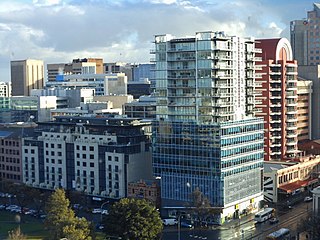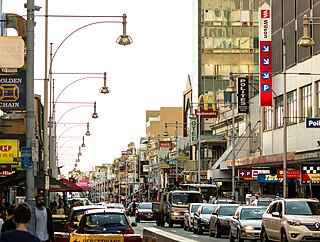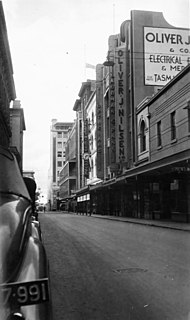
Rundle Mall is a pedestrian street mall located in Adelaide, South Australia. It was opened as a pedestrian mall in September 1976 by closing the section of Rundle Street between King William Street and Pulteney Street, to vehicular traffic. The street continues as Rundle Street to the east and Hindley Street to the west.

North Terrace is one of the four terraces that bound the central business and residential district of Adelaide, the capital city of South Australia. It runs east–west, along the northern edge of "the square mile". The western end continues on to Port Road, and the eastern end continues across the Adelaide Parklands as Botanic Road.

King William Street is the part of a major arterial road that traverses the CBD and centre of Adelaide, continuing as King William Road to the north of North Terrace and south of South Terrace. At approximately 40 metres (130 ft) wide, King William Street is the widest main street of all the Australian State capital cities. Named after King William IV in 1837, it is historically considered one of Adelaide's high streets, for its focal point of businesses, shops and other prominent establishments. The Glenelg tram line runs along the middle of the street through the city centre.
This is a timeline of Adelaide history.

Hindmarsh Square/Mukata is one of five public squares in the Adelaide city centre, South Australia. It is located in the centre of the north-eastern quarter of the city, and surrounds the intersection of Grenfell and Pulteney Streets, near the eastern end of the Rundle Mall. Pirie Street forms the southern boundary of the square.

Adelaide city centre is the inner city locality of Greater Adelaide, the capital city of South Australia. It is known by locals simply as "the City" or "Town" to distinguish it from Greater Adelaide and from the City of Adelaide local government area. The population was 15,115 in the 2016 census.

John Martin & Co. Ltd, colloquially known as John Martin's or simply Johnnies, was an Adelaide-based company which ran a popular chain of department stores in South Australia. It operated for more than 130 years, from 1866 until its closure in 1998. Johnnies, owned by the prominent Hayward family for the majority of its existence, became an Adelaide icon, responsible for the famous Adelaide Christmas Pageant.

Pulteney Street is a main road which runs north-south through the middle of the eastern half of the Adelaide city centre, in Adelaide, South Australia. It runs north-south from North Terrace, through Hindmarsh and Hurtle Squares, to South Terrace, where it becomes Unley Road, and subsequently,, becomes Belair Road.

Hindley Street is located in the north-west quarter of the centre of Adelaide, the capital of South Australia. It runs between King William Street and West Terrace. The street was named after Charles Hindley, a British parliamentarian and social reformist.

Palace Cinemas is the fifth largest major cinema chain in Australia, with various locations in CBD and inner suburban areas of most capital cities. Palace Cinemas currently comprises 24 cinemas with 180 screens and more than 550 staff. Its head office is based in the Melbourne suburb of South Yarra, close to its Cinema Como flagship.

Grenfell Street is a major street in the north-east quarter of the Adelaide city centre, South Australia. The street runs west-east from King William Street to East Terrace. On the other side of King William Street, it continues as Currie Street. Its intersection with Pulteney Street is encircled by Hindmarsh Square.

The Jubilee Exhibition Building in Adelaide, South Australia, was built to celebrate the 50th anniversary of Queen Victoria's accession to the throne on 20 June 1837. The jubilees of her Coronation on 28 June 1838, and of the Proclamation of South Australia on 28 December 1836, were also invoked on occasion.
Joseph Jackman was the founder of Jackman's Rooms which incorporated a restaurant "Jackman's Dining Room", meeting rooms, dance hall and banqueting room at 48–50 King William Street, Adelaide, and several other cafes in Adelaide, South Australia.

Hotel Mumbai is a 2018 action thriller film directed by Anthony Maras and co-written by Maras and John Collee. An Indian-Australian-American co-production, it is inspired by the 2009 documentary Surviving Mumbai about the 2008 Mumbai attacks at the Taj Mahal Palace Hotel in India. The film stars Dev Patel, Armie Hammer, Nazanin Boniadi, Anupam Kher, Tilda Cobham-Hervey, Jason Isaacs, Suhail Nayyar, Nagesh Bhosle, and Natasha Liu Bordizzo.
J. T. Fitch & Son was an Adelaide drapery store established by John Thomas Fitch, and carried on by his son John Thomas Fitch, jr.

Gawler Place is a single-lane road in the city centre of Adelaide, the capital of South Australia. It runs north to south from North Terrace to Wakefield Street, parallel to and approximately midway between King William and Pulteney Streets.
Charles Atkins Hornabrook JP was a businessman in colonial South Australia who made a fortune from property development in the city of Adelaide and investments in Broken Hill Proprietary and other mining prospects. He is remembered as the owner and developer of the York Hotel, at the time regarded as Adelaide's finest.
A Deutsche Schule operated in Adelaide between 1851 and 1878, teaching, among other subjects, German to English-speaking students, and vice versa.
H. L. Vosz was an Adelaide, South Australia business, for a time Australia's largest supplier of paints and glass, the earliest progenitor of Dulux paints, and became the prosperous glass merchants A. E. Clarkson Ltd. The company was founded in a modest way by a painter, plumber and glazier of more than usual business acumen, who unwittingly became the name behind many of the stained glass windows in South Australian churches and public buildings.



















